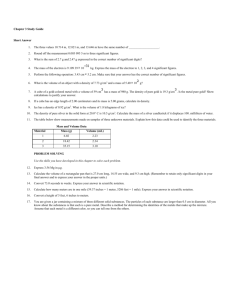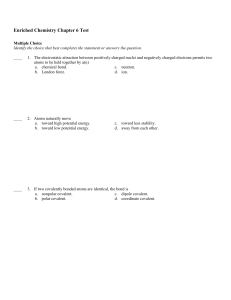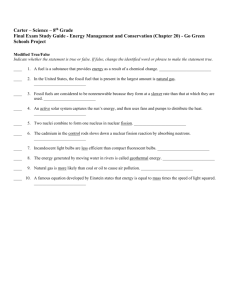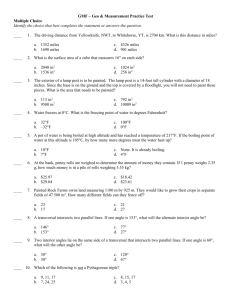stoiciometry_practice_quiz_11.3
advertisement
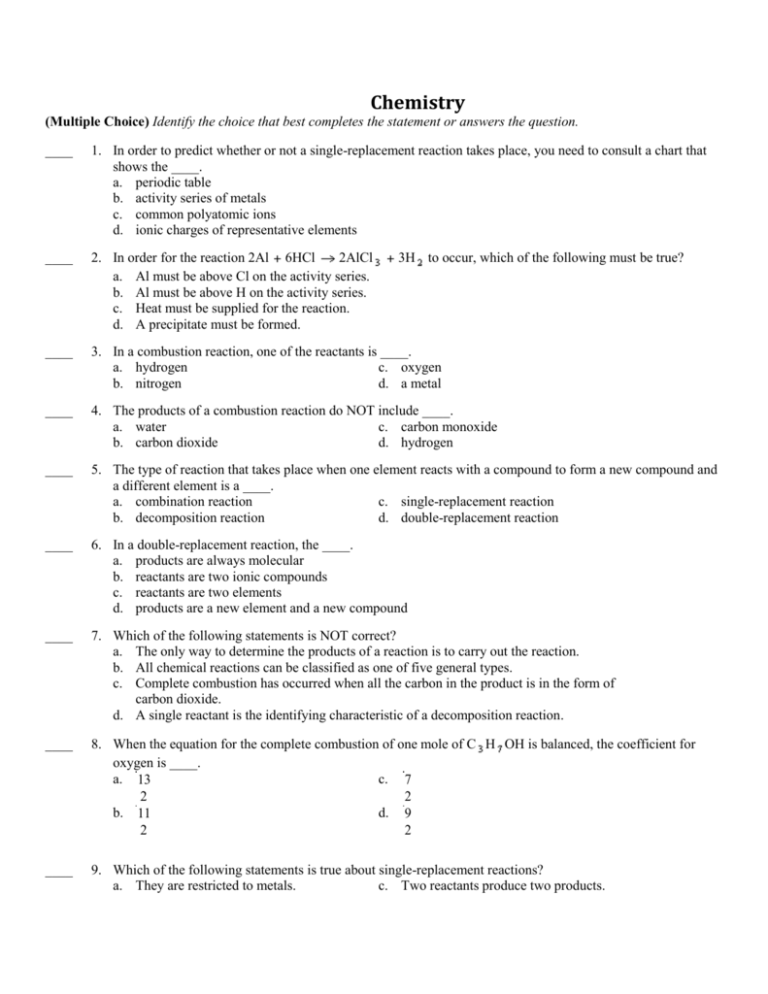
Chemistry (Multiple Choice) Identify the choice that best completes the statement or answers the question. ____ 1. In order to predict whether or not a single-replacement reaction takes place, you need to consult a chart that shows the ____. a. periodic table b. activity series of metals c. common polyatomic ions d. ionic charges of representative elements ____ 2. In order for the reaction 2Al 6HCl 2AlCl a. Al must be above Cl on the activity series. b. Al must be above H on the activity series. c. Heat must be supplied for the reaction. d. A precipitate must be formed. ____ 3. In a combustion reaction, one of the reactants is ____. a. hydrogen c. oxygen b. nitrogen d. a metal ____ 4. The products of a combustion reaction do NOT include ____. a. water c. carbon monoxide b. carbon dioxide d. hydrogen ____ 5. The type of reaction that takes place when one element reacts with a compound to form a new compound and a different element is a ____. a. combination reaction c. single-replacement reaction b. decomposition reaction d. double-replacement reaction ____ 6. In a double-replacement reaction, the ____. a. products are always molecular b. reactants are two ionic compounds c. reactants are two elements d. products are a new element and a new compound ____ 7. Which of the following statements is NOT correct? a. The only way to determine the products of a reaction is to carry out the reaction. b. All chemical reactions can be classified as one of five general types. c. Complete combustion has occurred when all the carbon in the product is in the form of carbon dioxide. d. A single reactant is the identifying characteristic of a decomposition reaction. ____ 8. When the equation for the complete combustion of one mole of C H OH is balanced, the coefficient for oxygen is ____. a. 13 c. 7 2 2 b. 11 d. 9 2 2 ____ 9. Which of the following statements is true about single-replacement reactions? a. They are restricted to metals. c. Two reactants produce two products. 3H to occur, which of the following must be true? b. They involve a single product. d. Any metal replaces any other metal. ____ 10. Which of the following statements is NOT true about double-replacement reactions? a. The product may precipitate from solution. b. The product may be a gas. c. The product may be a molecular compound. d. The reactant may be a solid metal. ____ 11. The complete combustion of which of the following substances produces carbon dioxide and water? a. C H c. CaHCO b. K CO d. NO ____ 12. Which of the following is the correctly balanced equation for the incomplete combustion of heptene, C H ? a. C H c. 2C H 14O 7CO 7H O 21O 14CO 14H O b. C H d. C H 7O 7CO 7H O O C O 7H ____ 13. The reaction 2Fe 3Cl 2FeCl is an example of which type of reaction? a. combustion reaction c. combination reaction b. single-replacement reaction d. decomposition reaction ____ 14. The equation Mg(s) 2HCl(aq) a. combination reaction b. single-replacement reaction MgCl (aq) H g is an example of which type of reaction? c. decomposition reaction d. double-replacement reaction ____ 15. The equation H PO 3KOH a. double-replacement reaction b. combination reaction K PO 3H O is an example of which type of reaction? c. decomposition reaction d. single-replacement reaction ____ 16. The equation 2C H OH 9O 6CO 8H O is an example of which type of reaction? a. combustion reaction c. double-replacement reaction b. single-replacement reaction d. decomposition reaction Short Answer 17. Balance the following equation. Indicate whether combustion is complete or incomplete. C H O CO H O 18. Balance the following equation. Indicate whether combustion is complete or incomplete. 2C H OH O CO H O = Essay 19. Predict the precipitate that forms when aqueous solutions of silver nitrate and potassium chloride react to form products in a double-replacement reaction. Include a discussion of how to write the complete chemical equation describing this reaction. Write net ionic equations. Answer Key 1. ANS: OBJ: 2. ANS: OBJ: 3. ANS: OBJ: 4. ANS: OBJ: 5. ANS: OBJ: 6. ANS: OBJ: 7. ANS: OBJ: 8. ANS: OBJ: 9. ANS: OBJ: 10. ANS: OBJ: 11. ANS: OBJ: 12. ANS: OBJ: 13. ANS: OBJ: 14. ANS: OBJ: 15. ANS: OBJ: 16. ANS: OBJ: 17. ANS: 2C H B 11.2.1 B 11.2.1 C 11.2.1 D 11.2.1 C 11.2.1 B 11.2.1 B 11.2.1 D 11.2.1 C 11.2.1 D 11.2.1 A 11.2.1 B 11.2.1 C 11.2.2 B 11.2.2 A 11.2.2 A 11.2.2 7O PTS: 1 DIF: L1 REF: Describe the five general types of reactions. PTS: 1 DIF: L1 REF: Describe the five general types of reactions. PTS: 1 DIF: L1 REF: Describe the five general types of reactions. PTS: 1 DIF: L1 REF: Describe the five general types of reactions. PTS: 1 DIF: L1 REF: Describe the five general types of reactions. PTS: 1 DIF: L1 REF: Describe the five general types of reactions. PTS: 1 DIF: L1 REF: Describe the five general types of reactions. PTS: 1 DIF: L2 REF: Describe the five general types of reactions. PTS: 1 DIF: L2 REF: Describe the five general types of reactions. PTS: 1 DIF: L2 REF: Describe the five general types of reactions. PTS: 1 DIF: L2 REF: Describe the five general types of reactions. PTS: 1 DIF: L2 REF: Describe the five general types of reactions. PTS: 1 DIF: L1 REF: Predict the products of the five general types of reactions. PTS: 1 DIF: L1 REF: Predict the products of the five general types of reactions. PTS: 1 DIF: L1 REF: Predict the products of the five general types of reactions. PTS: 1 DIF: L1 REF: Predict the products of the five general types of reactions. 6CO p. 333 p. 333 p. 336 p. 336 | p. 337 p. 333 p. 334 | p. 335 p. 330 p. 336 | p. 337 p. 333 | p. 334 p. 334 | p. 335 p. 336 | p. 337 p. 336 p. 330 | p. 337 p. 333 p. 334 | p. 335 p. 336 | p. 337 8H O (incomplete) PTS: 1 DIF: L3 REF: p. 327 | p. 336 OBJ: 11.1.3 Describe the steps for writing a balanced chemical equation. | 11.2.2 Predict the products of the five general types of reactions. 18. ANS: C H OH 3O 2CO 3H O (complete) PTS: 1 DIF: L3 REF: p. 327 | p. 336 OBJ: 11.1.3 Describe the steps for writing a balanced chemical equation. | 11.2.2 Predict the products of the five general types of reactions. 19. ANS: Because the reaction is a double-replacement type, cations are exchanged among compounds during the reaction. The first step is to write the equation in skeleton form: AgNO + KCl AgCl + KNO Inspection of this equation shows that the insoluble precipitate silver chloride forms in an aqueous solution of potassium nitrate. The relative amounts of elements are the same on either side of the equation, so the complete equation is: AgNO (aq) + KCl(aq) AgCl(s) + KNO (aq) (balanced) PTS: 1 DIF: L3 REF: p. 334 | p. 335 OBJ: 11.3.2 Predict the formation of a precipitate in a double-replacement reaction.





